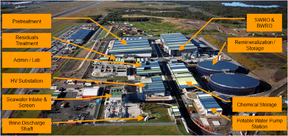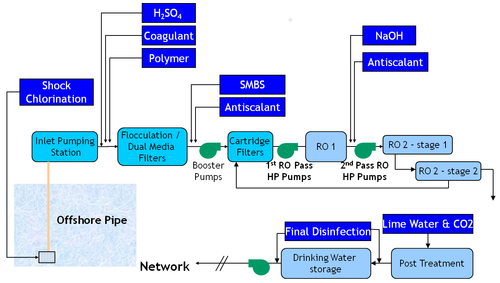Difference between revisions of "Gold Coast Desalination Plant"
From Desal Wiki
| Line 27: | Line 27: | ||
<imagemap> | <imagemap> | ||
Image:Pfd-gold_coast.png|none|thumb|500px | Image:Pfd-gold_coast.png|none|thumb|500px | ||
| − | rect 10 202 264 698 [[ | + | rect 10 202 264 698 [[Gold Coast Desalination Plant - Intake|Intake]] |
| − | rect 238 480 362 700 [[ | + | rect 238 480 362 700 [[Gold Coast Desalination Plant - Intake|Intake]] |
| − | rect 272 4 722 438 [[ | + | rect 272 4 722 438 [[Gold Coast Desalination Plant - Pretreatment|Pretreatment]] |
| − | rect 886 48 1156 216 [[ | + | rect 886 48 1156 216 [[Gold Coast Desalination Plant - Cleaning|Cleaning]] |
| − | rect 782 336 1274 490 [[ | + | rect 782 336 1274 490 [[Gold Coast Desalination Plant - RO|RO]] |
| − | rect 720 550 1254 738 [[ | + | rect 720 550 1254 738 [[Gold Coast Desalination Plant - Post-treatment|Post-treatment]] |
desc bottom-left | desc bottom-left | ||
</imagemap> | </imagemap> | ||
Revision as of 07:17, 13 November 2014
| Desal Plant Profile - Gold Coast Desalination Plant | |
|---|---|
 Labelled aerial photo of Gold Coast Desalination Plant Labelled aerial photo of Gold Coast Desalination Plant
| |
| Total capacity: | 133ML/day |
| Date commissioned: | February 2009 |
| Feed water TDS: | 34,000 mg/L - 39,000 mg/L [1] |
| Product water TDS: | 140mg/L [2] |
| Percent of water supply: | 27% of South Eastern QLD |
| feed water temperature (low): | 17°C290.15 K 62.6 °F 522.27 °R |
| Feed water temperature (high): | 28°C301.15 K 82.4 °F 542.07 °R |
| Seawater intake system: | Submerged open sea |
| Pretreatment system: | Ferric sulphate coagulation, sulphuric acid injection (pH reduction), polyDADMAC, dual media pressure filters |
| RO operating pressure: | First pass RO operating pressure - 64 bar (45% recovery). Second pass - 15 bar (85% recovery) [3] |
| RO passes: | 2 [3] |
| RO trains: | 9, 3 |
| Post-treatment system: | Lime stabilization, CO2, disinfection by sodium hypochlorite injection |
| Concentrate disposal: | Treated supernatant discharged to sea, solids centrifuged and landfilled |
| Energy consumption: | 3.58 kWh/m3 |
| Energy recovery: | Each RO train is fitted with dual-work exchanger energy recovery devices, which recover up to 97% of unused energy from the brine. Renewable energy certificates are being used to fully offset carbon emissions from the plant. |
| Capital cost: | $1200 million |
| Useful links: | http://www.water-technology.net/projects/gold-coast-plant/ |
Interactive process flow diagram
Water quality data
| Physical & Chemical Properties | |
|---|---|
| Turbidity: | 7 NTU |
| Cations |
|---|
| Anions |
|---|
References
- ↑ Billiton, BHP. Appendix H3: Comparisons With Other Desalination Plants Olympic Dams Supplementary EIS (pp. 2-5). [1] Accessed November 6th, 2014.
- ↑ Crisp, G. J. (2010). Desalination in Australia. Paper presented at the OC Water Summit, Grand Californian Hotel, Disneyland Resort. [2] Accessed November 6th, 2014.
- ↑ 3.0 3.1 Bellizia, G. (2008). GOLD COAST DESALINATION PROJECT. Paper presented at the 33rd Annual Qld Water Industry Operations Workshop, Indoor Sports Centre, Carrara, Gold Coast. [3] Accessed November 6th, 2014
